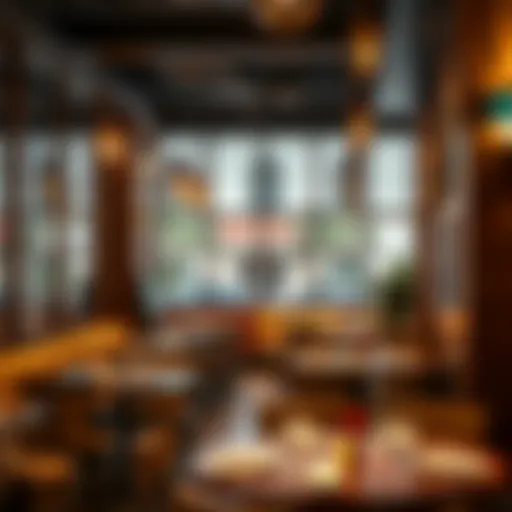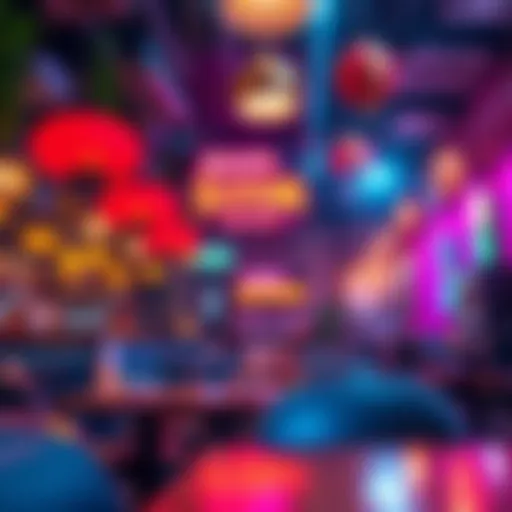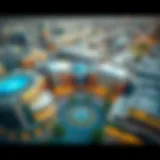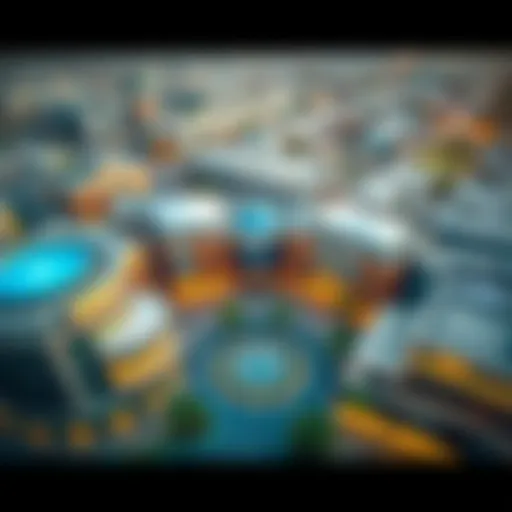Discovering the Architectural Wonders of Downtown Dubai


Intro
In the heart of Dubai lies a tapestry of architectural marvels, each building more than just a structure. They tell stories of ambition, innovation, and tradition. The skyline of downtown Dubai is not merely a collection of towers; it is a representation of a city's aspirations and cultural identity. As one navigates through this urban jungle, the distinct characteristics of each building reveal its purpose and significance within the broader framework of urban life.
For expatriates, tourists, and locals alike, understanding these buildings is key to appreciating the cultural essence of the city. Whether it’s the shimmering facade of the Burj Khalifa, the imaginative design of the Dubai Opera, or the contemporary artistry of The Dubai Mall, each edifice highlights a unique blend of functionality and aesthetic appeal.
This section serves as a springboard into the fascinating exploration of Dubai's downtown, delving into the neighborhood's characteristics, an analysis of the cost of living, and insights into lifestyle—where culture meets recreation.
Understanding these facets of Dubai’s architectural landscape not only enhances one’s appreciation of the city but also informs future endeavors, whether in real estate or travel planning. Let's embark on this journey into the architectural heart of Dubai.
Prelims to Downtown Dubai
Downtown Dubai is not just a geographical center; it's a symbol of innovation and magnificence that encapsulates the spirit of this dynamic metropolis. The significance of this area extends beyond its glitzy structures; it stands as a testament to the rapid development and transformation that Dubai has undergone over the past few decades. This place attracts expatriates, tourists, and locals alike, each drawn by its mesmerizing skyline and lively atmosphere. Whether you're a real estate agent seeking insights into property valuations or a curious tourist eager to soak in the culture, understanding what Downtown Dubai represents is crucial.
The buildings here tell stories of ambition, creativity, and resilience. Each one, from the towering Burj Khalifa to the stylish Dubai Mall, contributes to the area's architectural diversity. These structures are not mere façades; they are integral parts of a larger urban narrative, shaping communal experiences and reflecting the aspirations of the people. Focusing on the architectural landscape of this area paves the way for a deeper appreciation of its contributions to urban life.
Why is Downtown Dubai Important?
- Cultural Hub: The area blends modernity with tradition, showcasing art installations and cultural displays that enrich the community's identity.
- Economic Epicenter: Serving as a vital economic driver, it fosters business growth, attracting investments that contribute to Dubai’s prosperity.
- Tourism Magnet: With numerous attractions, it draws millions of visitors annually, elevating the city’s status on the global stage.
Understanding Downtown Dubai means recognizing its role as a vibrant epicenter of modern life where architectural beauty meets functionality. It invites conversations about urban living, community engagement, and the delicate balance between preserving cultural identity while embracing modernization. By looking into the roots of this urban landscape and its current advancements, one can better appreciate the unique charm and significance of Downtown Dubai.
"Downtown Dubai isn’t just a place you visit; it’s a living fabric woven with countless experiences waiting to unfold."
This exploration leads us seamlessly into a closer examination of what precisely defines this bustling hub and how its origins have shaped its present landscape.
Architectural Diversity
Architectural diversity in downtown Dubai stands as a testament to the city’s continual evolution and willingness to embrace a kaleidoscope of aesthetic approaches. This richness in styles not only reflects the historical influences that have shaped the region but also showcases the innovative spirit that lives at the heart of Dubai’s urban landscape. Diverse architecture serves important purposes such as cultural representation, economic growth, and practical functionality of spaces that cater to a wide range of residents and visitors.
In exploring architectural diversity, we see a fusion of traditional and modern elements. Buildings ranging from sleek skyscrapers to low-rise boutiques coalesce to create a distinctive skyline, drawing in expatriates, tourists, and locals alike. The design of each structure tells a story, inviting people to appreciate the crafting of spaces that resonate with both the city’s heritage and its forward-thinking ethos. This dynamism creates a sense of place that is both familiar and foreign—all at once.
Styles and Influences
The styles present in downtown Dubai showcase the city’s rich cultural tapestry. Elements of Islamic architecture, notably seen in decorative motifs and arches, coexist harmoniously with contemporary designs marked by clean lines and glass facades. This mix is not just for show; it engages people at various levels, encouraging interaction and participation in city life.
- Islamic Architecture: Often characterized by intricate geometric patterns, this style pays homage to the city’s cultural roots.
- Art Deco Influences: Some buildings display a flair for the dramatic, echoing the bold styles that emerged in the Western world in the early to mid-20th century.
- Futuristic Designs: Properties like the Burj Khalifa and Dubai Opera illustrate a daring vision for the future that pushes boundaries and escalates the conversation around modern design.
All of these styles create a narrative of continuity and duality, a conversation between the past and the present.
Iconic Structures
Burj Khalifa
The Burj Khalifa stands not merely as an architectural feat, but as a symbol of Dubai's ambition. Recognized as the tallest building in the world, its sheer height encroaches into the stratosphere, reflecting the aspirations of a nation that aims to be a global beacon. Key characteristics include its unique ‘Y’ shape, which not only adds to its aesthetic value but also enhances structural stability and energy efficiency.
The breathtaking viewing platform on the 148th floor offers a panoramic view that captivates both tourists and residents. However, the building is not without its criticisms; issues such as overcrowding and the high maintenance costs associated with its upkeep often make headlines. Still, its iconic status remains unquestionable, as it continually draws people for both business and pleasure.
Dubai Mall
Adjacent to the Burj Khalifa, the Dubai Mall is a sprawling complex that goes beyond shopping. It integrates leisure, entertainment, and dining, making it a microcosm of urban life in the city. The mall's design is grand, boasting an impressive glass façade that allows natural light to flood in, creating an inviting atmosphere.
One unique feature is the underwater aquarium, which captivates children and adults alike. While it can be viewed as merely a shopping center, it is a crucial contributor to the local economy, attracting millions of visitors annually. But, with that popularity comes the inevitable challenges of managing crowd flow and maintaining a comfortable browsing experience.
Dubai Opera
The Dubai Opera sets itself apart with its opulent design that resembles a traditional sailing vessel. This architectural gem plays host to a myriad of cultural events, from opera to ballet to concerts, enriching the local arts scene while blending seamlessly into the contemporary urban fabric.
Its unique aesthetic serves as a backdrop for numerous social and cultural gatherings, establishing it as a cultural hub. Nonetheless, some critics argue that the cost of maintaining such an elaborate venue could be better channeled into community initiatives. Regardless, its contribution to the overall cultural identity of downtown Dubai cannot be undermined, as it continues to inspire a love for the arts in residents and visitors.
"The architectural landscape of Dubai is a mirror reflecting both its history and its daring future. We might think of the skyline as a dialogue across time—an invitation to engage, explore, and understand."
The vibrant architectural narrative of downtown Dubai enriches the life of its citizens and visitors alike, making it not just a destination, but a living canvas that continues to evolve.
Urban Planning and Design
Urban planning and design in downtown Dubai plays a pivotal role in shaping the city's identity and functionality. It's not just about where buildings sit or how they look; it's about creating an environment that encourages community interaction, supports economic growth, and respects the cultural backdrop of this vibrant landscape.
When examining downtown Dubai, the impact of urban planning becomes evident in the harmonious balance between residential areas, commercial spaces, and recreational zones. The strategic placement of skyscrapers like the Burj Khalifa and the Dubai Mall not only enhances the skyline but also amplifies the vibrancy of city life. It's a careful choreography of architecture and urbanism that prioritizes accessibility and user experience while maximizing land use.
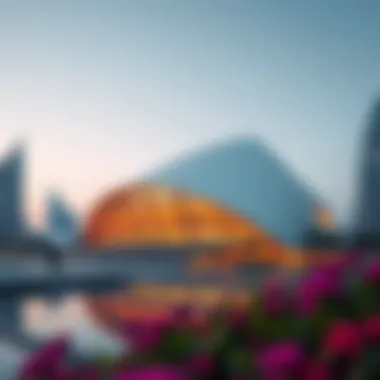
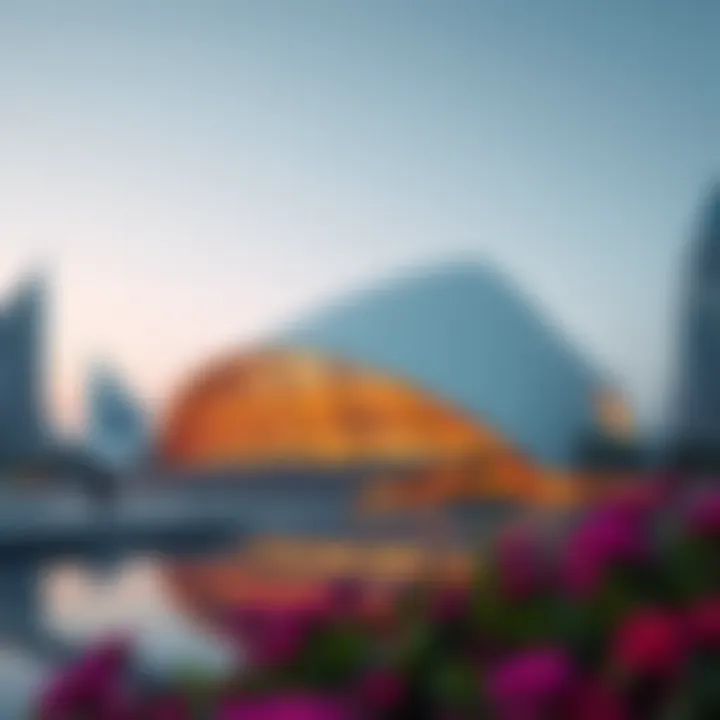
Zoning Regulations
Zoning regulations act as the guiding compass for urban planners in Dubai. These rules dictate where certain types of buildings can be constructed, what heights they can reach, and how they can be utilized. This is crucial for maintaining an orderly development that reflects both the ambitions of the city and the needs of its residents.
For instance, mixed-use zoning can lead to neighborhoods that seamlessly blend residential living, workspaces, and leisure activities. Such arrangements reduce the time residents spend commuting and enhance interactions among different segments of the population. This regulatory framework is not merely a bureaucratic formality; it allows for sustainable development that aligns with global best practices and local traditions.
Public Spaces
Public spaces are the lifeblood of urban living, providing areas where people can gather, socialize, and engage in recreational activities. They significantly contribute to the overall quality of life in the densely packed downtown area.
Green Spaces
Green spaces such as parks and gardens offer a refreshing contrast to the concrete jungle. These areas not only beautify the environment but also promote mental well-being by offering a sanctuary from city life's hustle and bustle. The greenery signifies a shift towards a more sustainable urban landscape, showcasing Dubai’s commitment to preserving nature amid rapid urbanization.
A prominent example is the Burj Park, located near the Burj Khalifa. This unique feature not only provides a picturesque spot for picnics but also serves as a public venue for art exhibitions and cultural gatherings. The advantage of green spaces in downtown Dubai is that they foster community spirit and enhance public health by encouraging outdoor activities.
Recreational Areas
Recreational areas are essential for fostering an active lifestyle among the city's residents and visitors. These spaces include playgrounds, sports facilities, and leisure zones designed for multiple activities.
A notable feature is the Dubai Fountain area, which hosts evening shows that attract thousands. Such attractions provide a common ground for families, tourists, and locals alike, promoting community engagement and cultural exchange. The recreational areas also serve as venues for events and festivals, strengthening the social fabric of the city.
While the benefits are evident, it’s crucial to consider the balance between developing these areas and preserving the natural environment. As more recreational projects are rolled out, careful planning is needed to ensure they do not encroach on valuable green spaces or disrupt local ecosystems.
"The structure and space we create today will determine how our communities function tomorrow."
For further reading, check out the Urban Planning section on Wikipedia or explore detailed reports from the Dubai Land Department.
Cultural Significance
Cultural significance in urban contexts often goes beyond mere aesthetics; it encompasses the very essence of a city's identity and its community's values. In Downtown Dubai, the cultural weight of its buildings cannot be overstated.
The architecture here acts as a narrative thread, intertwining historical references with forward-thinking design, contributing to an ever-evolving cultural tapestry. Each structure stands tall, not just as a landmark but as a representation of the ambitions and dreams of its people.
Representation in Architecture
When examining the representation of culture in architecture, one can observe a myriad of influences, merging traditional motifs with modern innovations. For example, the Islamic design principles that echo through the intricate facades of buildings like the Dubai Opera narrate stories of past generations, reminding the onlooker of their heritage. It’s fascinating how the interplay between classical elements and contemporary lines helps create a sense of place in a bustling metropolis.
Moreover, the Burj Khalifa, soaring into the sky, is not just a tall building; it symbolizes hope and the vibrant spirit of Dubai. This blend of old and new is a recurrent theme in Dubai’s skyline; it is a testament to unyielding growth against the backdrop of history. The evolution of architectural styles illustrates a commitment to honoring the past while embracing the future.
The buildings conversing through their forms serve as daily reminders to residents and visitors of a shared identity and collective aspirations.
Community Engagement
Community engagement through architecture is about how spaces invite interaction and foster connections among individuals. In Downtown Dubai, buildings have begun to act as conduits for community interaction, designed not only to house but also to gather. Public plaza spaces like those surrounding the Dubai Mall are prime examples. They provide much-needed respite in an urban setting while also acting as stages for social gatherings, concerts, and cultural festivities.
This social aspect becomes crucial in a city that attracts many different people from around the globe.
The community-focused designs work toward breaking barriers, encouraging both locals and expatriates to gather and appreciate cultural exchanges, whether through art displays, local markets, or culinary experiences.
Furthermore, initiatives aimed at accentuating public spaces, such as parks and leisure areas, enhance the quality of life, inviting people to enjoy the environment. Such developments reflect a conscious effort by city planners to weave community ties and give momentum to collective social experiences.
In summary, the significance of cultural representation and community engagement in Downtown Dubai's architecture transcends mere physical structures. It breathes life into the city, ensuring that each edifice built is not just a product of construction but a living narrative of evolving identity.
Sustainability Initiatives
In the age of global warming and ecological imbalance, the concept of sustainability is not just a buzzword but an essential strategy for the future of urban environments. In Dubai, where the skyline is a testament to modernity, the focus on sustainability initiatives is paramount. This stems from the understanding that sustainable practices can drive economic growth, enhance quality of life, and protect the environment. While it may seem daunting, integrating sustainability into urban development is both a goal and a necessity.
Green Building Practices
Green building practices are pivotal in shaping eco-friendly urban landscapes. These practices aim to reduce a building's overall environmental impact through various methods and technologies. In Dubai, this often translates into using materials that are sustainable, energy-efficient systems, and construction practices that minimize waste.
- Energy Star Rated Products: Many new buildings prioritize the use of energy-efficient appliances to reduce power consumption.
- Sustainable Materials: Utilizing locally sourced materials helps cut down on transportation emissions, while also supporting the local economy.
- Rainwater Harvesting: Innovative designs often include systems to collect and use rainwater, minimizing excessive use of groundwater.
Adopting green building practices does more than just promote sustainability; it often leads to lower operational costs and healthier living conditions. When residents breathe cleaner air and waste less energy, it translates directly into improved quality of life, something that underscores the community-oriented ethos of Dubai.
Energy Efficiency
Energy efficiency is crucial for both environmental conservation and economic viability. In a rapidly developing city like Dubai, optimizing energy use is a major focus. Buildings that are designed with energy efficiency in mind are not only beneficial from an ecological perspective but also economically sound.
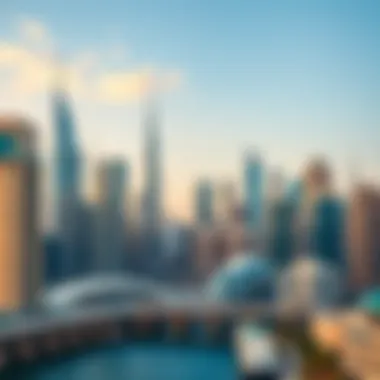
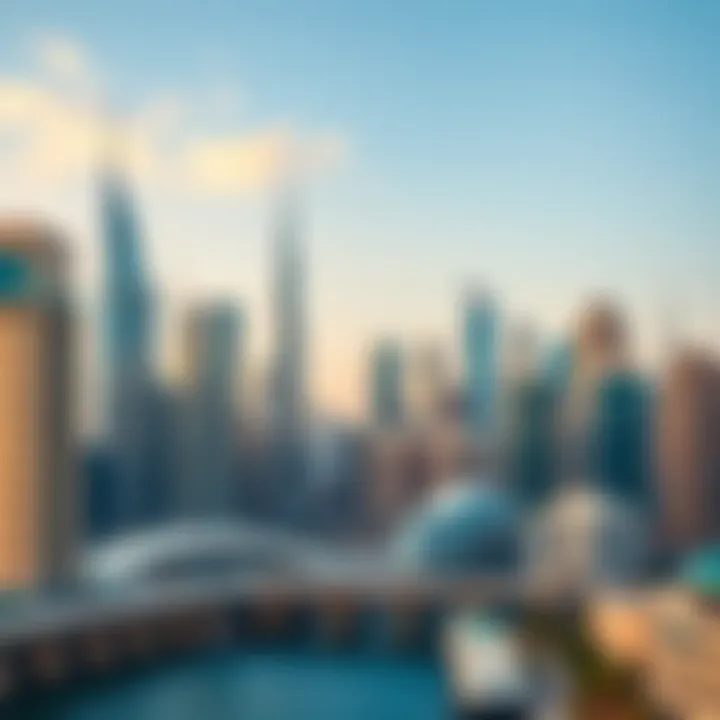
*Modern buildings incorporate:
- LED Lighting: Offers significant energy savings compared to traditional lighting.
- Smart Thermostats: Automatically adjust temperature settings based on occupancy, which can lead to substantial energy savings.
- High-Performance Glazing: Windows designed to reflect heat while allowing light can greatly reduce reliance on air conditioning.*
Energy-efficient buildings can reduce energy consumption by up to 30% or more, creating a win-win for both developers and residents.
The push towards energy efficiency in downtown buildings is reflective of a broader trend that integrates sustainability into the fabric of urban living. Developers not only have an incentive to lower costs but also contribute meaningfully to a greener future. Thus, the initiatives in energy management play a vital role in positioning Dubai as a leader in sustainable urban living.
For more information on sustainability initiatives in urban environments, visit Wikipedia and gain insight into effective strategies being implemented globally.
Economic Impact
Examining the economic impact of Dubai's downtown buildings is essential to understanding their role as catalysts for growth and development within the city. Much more than mere brick and mortar, these structures symbolize investment, innovation, and ambition. They are pivotal in attracting foreign investments, influencing job creation, and boosting the local economy in ways that are not always apparent at first glance.
Real Estate Dynamics
The dynamism of real estate in Downtown Dubai is a reflection of both local and global economic trends. The construction of high-profile buildings has a domino effect on surrounding neighborhoods. Vacant lots turn into bustling residential or commercial spaces, leading to a rise in property values. Not only do skyscrapers like the Burj Khalifa elevate the skyline, but they also set the stage for luxury living and commercial investment.
A few points to consider in the context of real estate dynamics include:
- Increased Demand: The allure of living or working in a prime location can cause a spike in demand for real estate in the area. Thus, the ripple effects can impact markets across the city.
- Investment Opportunities: Investors seek properties that are likely to appreciate, and iconic buildings tend to attract both local and international buyers, adding layers of investment complexity to the real estate landscape.
- Commercial Growth: As the downtown area flourishes, so do the business opportunities. More businesses mean more jobs, which in turn affects the housing market and local services.
The high-rise buildings attract both long-term residents and transient populations, creating a vibrant community that feeds back into the economic engine of the city.
Tourism and Business Growth
The impact of downtown buildings on tourism cannot be overstated. Each shiny skyscraper indicates a new piece of the touristic puzzle. Not just serving as places of work, many of these structures house hotels, retail spaces, and attractions that draw millions of visitors annually. For instance, the Dubai Mall isn't just the biggest mall; it is also home to attractions like an aquarium, ice rink, and countless dining options, brilliantly constructed under the shadow of the Burj Khalifa.
Key aspects related to tourism and business growth include:
- Global Icon Status: Buildings like the Burj Khalifa and Dubai Opera have become synonymous with the UAE’s luxury image. They pull in international tourists eager to experience the latest architectural marvels.
- Event Hosting: Many downtown buildings serve as venues for world-class events, exhibitions, and conferences. This boom in events brings in significant revenue, boosting various sectors within the local economy.
- Experiential Tourism: The way modern architecture interacts with local culture creates unique experiences — a mix of tradition and innovation that captivates visitors. People don't just visit these structures; they're part of a greater narrative that emphasizes luxury and unique experiences.
"In the heart of Dubai, skyscrapers do more than touch the sky; they forge connections across cultures and economies, creating a vibrant tapestry of life and commerce."
In essence, the economic impact of downtown buildings is profound. Their role in shaping real estate dynamics and enhancing tourism is interconnected, driving growth while reflecting the ambitions of a city that aims to set the benchmark for urban excellence. As Dubai continues to evolve, its iconic skyline will invariably chart a course through changing economic landscapes.
Technology in Construction
The evolution of construction technologies plays a vital role in shaping the architectural landscape of Downtown Dubai. With extensive investments in innovative techniques and materials, buildings not only cater to aesthetic desires but also promote functionality and sustainability. New technologies enhance the safety, efficiency, and longevity of structures. Let's explore how these advancements manifest in this vibrant urban setting.
Innovative Materials
The choice of materials is crucial in determining a building's sustainability and aesthetic appeal. In Downtown Dubai, you'll find a range of smart materials being used, often designed to withstand the region's harsh climate. For instance, the incorporation of heat-reflective glass reduces the need for excessive air conditioning, while lightweight, high-strength concrete aids in constructing taller skyscrapers without compromising structural integrity. These materials aren't just a trend; they reflect the urgent need for energy-efficient structures that can handle the severe heat while remaining stylish and futuristic.
Benefits of Innovative Materials:
- Energy Efficiency: Reduces carbon footprints by minimizing energy consumption.
- Aesthetic Versatility: Allows for more creative designs, enhancing the skyline.
- Durability: More resistant to erosion and weather elements, ensuring longevity.
Adopting such materials is not without challenges. Builders often face rigorous regulations on sourcing and implementing these elements, requiring cooperation between architects, engineers, and government bodies to adhere to local standards.
"Innovative materials allow for a dynamic interplay between design and functionality, creating a dialogue between the building and its environment."
Smart Building Features
The integration of technology does not stop at materials; smart buildings are becoming the norm in Downtown Dubai. These constructions are equipped with Internet of Things (IoT) devices and smart systems that optimize energy use and enhance the living experience. For instance, many structures, including residential towers and commercial complexes, have implemented automatic lighting systems that adjust based on natural light availability.
Some common smart features include:
- Automated Climate Control: Uses sensors to adjust heating/cooling based on occupancy.
- Energy Management Systems: Monitors and optimizes energy consumption.
- Advanced Security Systems: Integrates surveillance and access control through smart technology.
These features offer considerable benefits, such as reduced operational costs and improved safety measures. However, they also present challenges, such as potential cybersecurity risks and the need for ongoing tech upgrades to keep pace with rapidly changing technology.
In summary, the embrace of technology in construction not only redefines how buildings are made but also how they interact with people and the environment. This focus on innovation sets a framework for future development in Downtown Dubai, ensuring that it remains at the forefront of architectural evolution.
Future Trends in Downtown Development
The evolution of Downtown Dubai is marked by a relentless pursuit of innovation and aesthetics, intertwining modernity with tradition. Understanding the future trends within this vibrant urban landscape is critical to appreciating how these developments will shape the social and physical fabric of the city. As Dubai continues to evolve, certain emerging trends promise to redefine not just the skyline, but also the way inhabitants interact with their environment.
Upcoming Projects
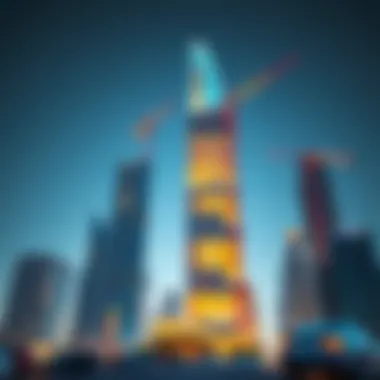

In the pipeline are a number of ambitious projects that are set to continue transforming Downtown Dubai. Notable among these is the Dubai Creek Tower, designed to surpass even the heights of the Burj Khalifa. This striking structure aims to blend technological advances with cultural representation, thereby enhancing the diversity of architectural styles in the area.
Another significant undertaking is the Dubai Square, a mega retail and entertainment complex which aspires to redefine shopping experiences by opening up new avenues of leisure and lifestyle. This endeavor aims to diversify the urban offering, appealing to both residents and tourists by merging boutiques, restaurants, and public spaces in one cohesive complex.
As sustainability becomes a focal point in urban planning, projects like the Sustainable City in Dubai are steering future developments. Here, eco-friendly initiatives take precedence, ensuring that the advancements align with global sustainability goals.
- Key upcoming projects:
- Dubai Creek Tower
- Dubai Square
- Sustainable City
These projects are a clear indication that Downtown Dubai isn’t just resting on its laurels; it’s preparing to leap into a new era of urban living and architectural wonder.
Shifts in Urban Living
As new structures rise, they signal shifts in the fabric of urban living. The integration of smart technologies in buildings is quickly becoming the norm. Structures equipped with state-of-the-art automation systems and responsive designs are facilitating better energy management and enhanced comfort for residents. This transformation is deeply rooted in the understanding that effective urban living relies heavily on technological advancements.
Moreover, the trend towards mixed-use developments is on the rise. This approach fosters vibrant communities where work, leisure, and living spaces coexist in harmony. Such developments invite a diverse populace into Downtown, enhancing its cultural richness and social dynamics.
- Trends influencing urban living:
- Smart technology integration
- Mixed-use developments
The implications of these shifts are vast, as they promise a more connected and accessible environment where residents and visitors alike can thrive, engage, and ultimately define what it means to live in a modern metropolis like Dubai.
"Urban living is redefining itself through innovation and sustainability, ensuring that as we grow, we remember to care for both our people and our planet." - Urban Planning Expert
By staying ahead of these trends, Downtown Dubai not only embraces change but also molds it, making the case for why it remains a quintessential example of modern urban development.
Regulatory Framework
The regulatory framework underpinning the vertical skyline of Dubai is crucial for maintaining order and harmony in the city's architectural development. These regulations govern everything from zoning laws to safety standards, ensuring that the unique character of the downtown area is preserved while meeting the demands of rapid urbanization. Striking a balance between creative expression and legal stipulations is a tightrope walk that developers and architects must navigate carefully.
Building Codes and Standards
Building codes in Dubai, particularly in downtown areas, focus on safety, durability, and environmental responsibility. The Dubai Municipality sets forth stringent guidelines that all construction must adhere to, including standards for materials, design, and safety measures. This means that developers must consider things like fire safety, structural integrity, and even energy efficiency from the very outset of their projects.
- Fire Safety Measures: With tall structures like the Burj Khalifa, fire safety regulations are rigorously enforced, ensuring comprehensive evacuation plans are in place.
- Energy Efficiency Standards: As Dubai continues to push for sustainability, buildings are increasingly required to incorporate energy-efficient technologies.
These codes not only safeguard public interests but also stimulate innovation in construction practices. The interplay between adhering to regulations and incorporating cutting-edge technology can lead to remarkable outcomes.
Government Initiatives
The government of Dubai has launched various initiatives designed to enhance urban development while ensuring it aligns with broader socio-economic goals. One notable initiative is the Dubai 2040 Urban Master Plan, which aims to create a sustainable and inclusive urban environment. This plan emphasizes the integration of green spaces and community-oriented facilities to uplift the overall quality of life.
Other government initiatives include:
- Smart City Strategy: To leverage technology for improving municipal services and residents’ quality of life.
- National Vision 2021: Aiming for sustainable economic growth and ensuring that development remains aligned with environmental preservation principles.
These initiatives not only shape how buildings can be constructed but also affect the community at large, influencing where people live, work, and socialize.
A comprehensive regulatory framework in Dubai reflects the city’s aspiration to not just grow but grow responsibly, ensuring that modern development respects historical integrity and public safety.
In summary, the regulatory landscape in downtown Dubai molds the architectural development of the area significantly. Compliance with building codes ensures that safety and sustainability are prioritized while government initiatives provide a roadmap for impactful urban growth.
Epilogue
In examining the architectural marvels of Downtown Dubai, we arrive at a significant understanding of their broader implications. This conclusion serves as not just a closing chapter but as a vital reflection on the elements that make these buildings, and their surrounding urban ecosystem, pivotal to the identity of the city. The essence of this discussion lies in the interplay between design, culture, and sustainability—three pillars that form the foundation of Dubai's skyline.
Summary of Key Insights
Throughout this article, we’ve traversed various aspects that outline the architectural significance of Downtown Dubai. Here’s a distilled summary of key insights from our exploration:
- Architectural Diversity: The unique blend of styles that encapsulate both modern and traditional influences.
- Cultural Significance: How these structures are not merely buildings but representations of cultural identity and social connectivity.
- Sustainability Initiatives: The focus on green practices and energy efficiency that reflects a commitment toward environmental stewardship.
- Economic Impact: The contribution of these structures to the local economy through tourism and real estate growth.
- Technological Integration: Emphasis on innovative materials and smart features that redefine urban living.
- Future Trends: Insights into upcoming projects and shifts that will define the urban landscape of Dubai.
The culmination of these insights underlines the fact that Downtown Dubai is more than just a collection of high-rises—it is a dynamic convergence of history, culture, and innovation, continually reshaping urban identity in response to both local and global influences.
Final Thoughts on Urban Identity
As we step back to consider the overall narrative, it becomes clear that the architectural landscape of Downtown Dubai is a mirror reflecting the city's ambitions and aspirations. Each building contributes to a larger story, one where modernity meets tradition, and where innovation coexists with sustainability. This creates a provocative dialogue about what it means to belong to a city that stands as a beacon of progress.
Dubai is a living testament to urban evolution, constantly adjusting to the demands of its populace and the shifting global climate. Expatriates, locals, and tourists alike encounter this blend daily, reinforcing the notion that architecture influences not just aesthetics but also the essence of community and identity.
Ultimately, recognizing the cultural and economic significance of these structures enhances our understanding of urban living in a constantly shifting environment. The identity of Downtown Dubai, marked by its striking silhouettes against the horizon, is being crafted one building at a time—a narrative of resilience, innovation, and an unwavering vision for a cohesive future.
"Architecture is the thoughtful making of space." - Louis Kahn



